30 Content Marketing Statistics for 2024 and Beyond
Editor’s Note: This post was originally published in February 2018 and was updated in September 2024 for accuracy and comprehensiveness.
Content marketing is the practice of promoting your business through blogs, videos, social media posts, and other types of content.
It’s primarily about consistently providing your target audience with free value. This helps you increase website traffic, grow your social media following, generate new leads, and earn the trust of potential customers.
In this post, we’ll walk through 30 eye-opening content marketing stats to help elevate your content game through 2024 and beyond.
1. 90% of Marketers and Business Owners Use Content Marketing as Part of Their Marketing Strategy
But even though so many businesses now engage in content marketing, your chances of success are still increasingly high.
In fact, just 3% of surveyed marketers describe their content marketing efforts as unsuccessful. That’s down from 9% in 2022.
2. 80% of Very Successful Content Marketers Have A Documented Content Strategy
Meanwhile, only 52% of unsuccessful content marketers have a defined content strategy.
This shows that having a thought-out content plan increases the likelihood of success, no matter the size of your business.
3. 41% of Global Marketing Leaders Increased Their Content Budgets in 2023
And 45% of them will increase content spending throughout 2024.
In other words, content investment looks set to accelerate for the foreseeable future. Businesses that overlook this area of marketing risk falling behind.

4. 22% of Marketers Have an Advanced Content Marketing Strategy
Meanwhile, 42% of marketers say their strategy is fairly developed.
While 36% are in the first steps of developing their content marketing program.

5. 69% of Marketers Spend More than 10% of Their Budgets on Content Marketing
This figure increases to 79% for the most successful marketers. And just 53% for the least successful.
Around 53% of responding marketers spend $3,000 or more per month on their content marketing program. Those who spend less than $1,000 per month tend to get fewer results.
6. 53% of Surveyed Marketers Spend $550 to $2000 Per Piece of Content in 2024
And businesses that spend more per piece enjoy greater content marketing success.
In fact, businesses that spend $4,000 per piece are 2.6 times more likely to report having a “very successful” strategy compared with those that spend $500 or less.
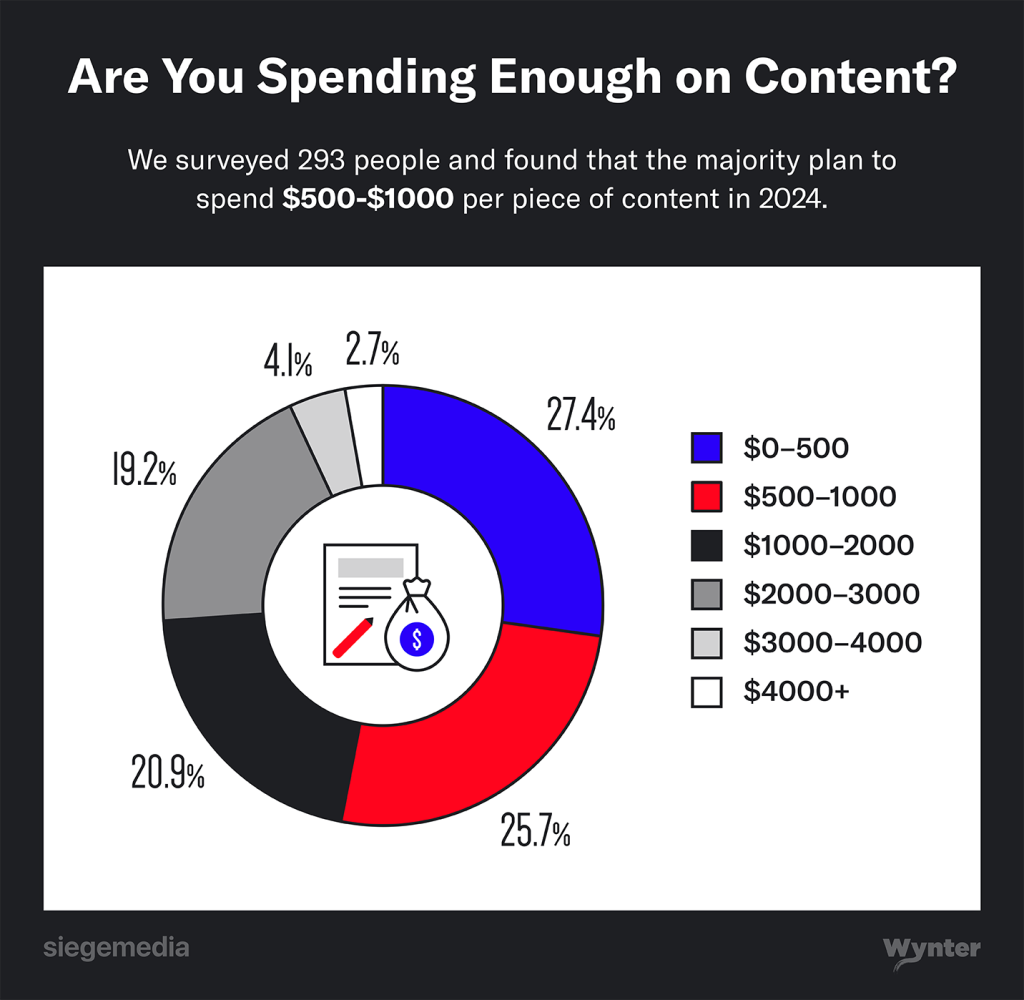
7. Content Marketing Costs 62% Less Than Other Types of Campaigns
And content marketing produces around three times as many leads as traditional marketing methods.
This is because content marketing typically relies on owned media and assets. You don’t need to pay for ad placements.
8. The Average Blog Post Length Is 1,427 Words
That’s 77% longer than it was back in 2013.
This goes hand-in-hand with the fact that bloggers now take 60% longer to write their posts. And the average time it takes to write a post is 3 hours 51 minutes.
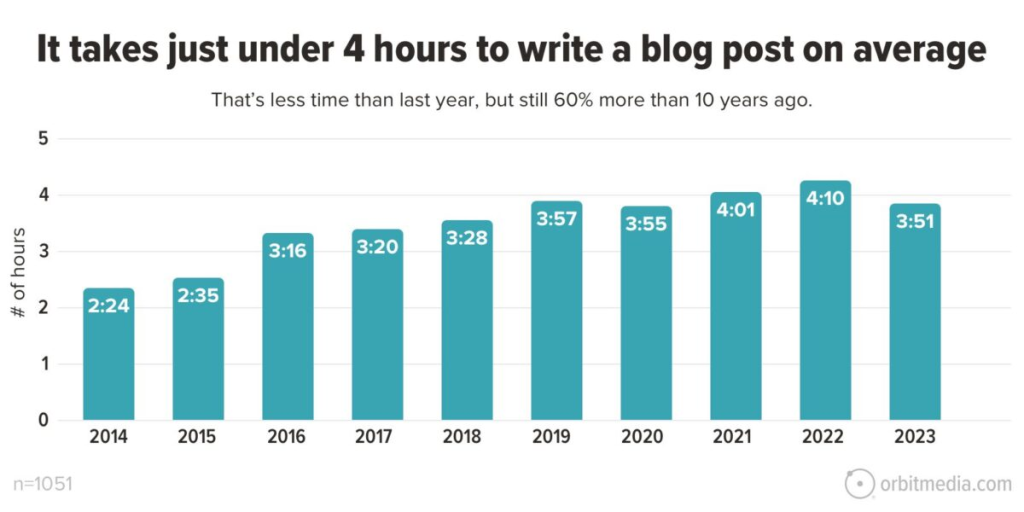
So, what explains this trend towards longer posts?
It’s simple: Longer posts tend to be more in-depth and provide readers with more value.
But you shouldn’t just write long-form content for the sake of it. The simplest way to determine the appropriate length of a post is to check the top-ranking results for that topic. If they tend to be around 2,000 words, then you should aim for a similar word count.
9. 45% of Marketers Say That Posting Content More Frequently Drives Results
And 55% say that creating more content helps boost their search engine rankings.
The takeaway here is that content quantity—not just quality—can be a decisive factor in increasing your content visibility.
10. 54.4% of Organic Search Clicks Go to the Top 3 Results
Put simply, ranking at the top of the search results gets you the lion’s share of clicks.

In fact, moving up just one position in Google’s results will, on average, improve your click-through rate (CTR) by 32.3%.
So, what’s the best way to steadily increase your rankings over time?
By investing in a comprehensive SEO strategy.
11. 46% of Google Searches Have Local Intent
If your business serves customers in a specific location, you can’t afford to ignore local SEO.
One of the most effective ways to boost your brand’s local search visibility is to optimize your Google Business Profile.
This is a free business listing that displays key details about your company directly in Google Search and Maps.
Like this:
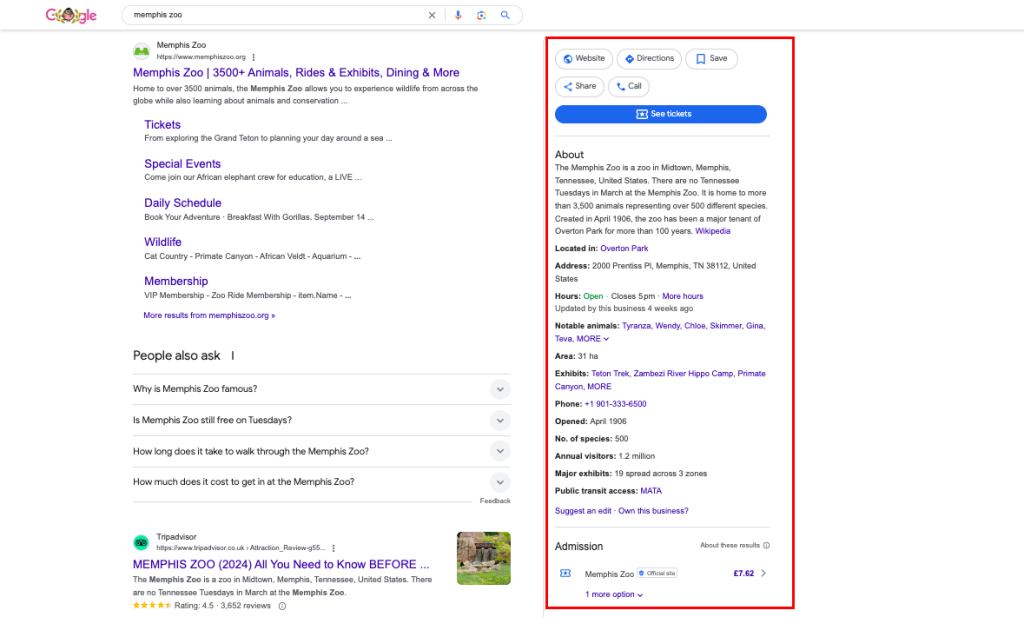
12. 83% of B2C Marketers Use Website Traffic to Track Content Performance
Other popular content performance metrics include email engagement, website engagement, and conversions.
It’s worth noting that 18% of B2C marketers surveyed don’t track content performance at all.
13. 84% of B2C Marketers Differentiate Their Content from the Competition by Focusing on Content Quality
Standing out from the crowd is a major challenge for content marketers.
Unsurprisingly, one of the most effective ways to gain a competitive advantage is to commit to producing high-quality content.
Another common method is to cover topics that your competitors don’t.

14. 57% of B2B Marketers Struggle to Create the Right Content for Their Audience
Working out which type of content will resonate best with your audience is no simple task.
And with the recent explosion of AI-generated content, it can be even harder to come up with new content ideas that cut through the clutter.
Here’s a breakdown of the main content challenges for B2B marketers:

15. 53% of B2B Marketers Say Case Studies Are the Most Effective Content Format
Case studies and success stories are especially good at moving prospects from the consideration stage to the decision stage of the buyer’s journey.
53% of respondents also say that video content is particularly effective at driving results.

16. 90% of B2B Marketers Use Social Media for Organic Content Distribution
79% of marketers distribute content through blogs. And 73% of them through email newsletters
The most effective distribution channels are webinars and in-person events—which 56% of B2B marketers use.
17. 84% of B2B Marketers Said LinkedIn Provided the Best Value of All Organic Social Channels in 2023
This explains why 72% of B2B marketers used LinkedIn more in 2023 than in 2022.

Of course, LinkedIn offers some unique advantages when it comes to B2B marketing.
The platform’s focus on business-related content allows B2B marketers to build thought leadership, foster professional relationships, and generate high-quality leads more effectively than other social channels.
18. 19% of B2B Marketers Used TikTok in 2023
For perspective, that’s more than double the amount that used the platform in 2022.
It seems B2B marketers are starting to recognize the potential of TikTok as a platform for reaching a broader audience and engaging in more creative, relatable ways.
19. 73% of All Marketers Use Organic Social to Promote Content
Email marketing paid social, and organic search are also popular promotion methods.

20. 31% of Marketers Use Email Marketing
Around 43% of email marketers send at least one email per day.
And a further 27% send emails more than once per week.

21. 47% of People Open Emails Based On the Subject Line Alone
At the same time, 69% of people report emails as spam based on their subject lines and nothing else.
In other words, crafting click-worthy subject lines is crucial for successful email marketing.
Good subject lines are concise and relevant and create a sense of urgency or curiosity. They should also be personalized whenever possible, addressing the recipient’s needs or interests.
22. 50% of Americans Use Voice Search Every Day
This includes 58% of 25 to 34 year olds.
People often use voice search for information about local business information—making it an essential consideration for local SEO.
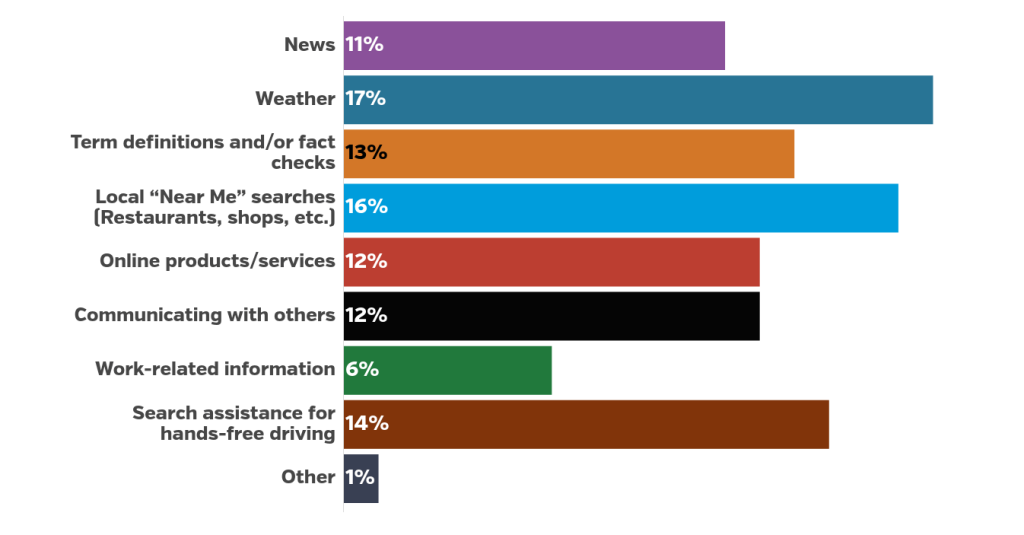
23. 41% of Marketers Plan to Invest More in Voice Search Optimization Throughout 2024
One of the simplest ways to capitalize on voice search is to structure content in a question-and-answer format.
After all, that’s how users typically engage with voice assistants.
So, instead of just using short keywords, focus on long-tail, conversational phrases that mirror how people naturally speak. For example, rather than optimizing for “best smartphone,” consider “What is the best smartphone for photography?”
24. Mobile Accounts for 63% of Organic Searches in the U.S.
Also, Google only looks at the mobile version of your website for indexing and ranking purposes (mobile-first indexing).
So it’s clear that optimizing your content for mobile users is no longer optional—it’s essential for SEO success.
25. 91% of Businesses Use Video for Marketing in 2024
For comparison, this figure was just 61% in 2016.
90% of video marketers say the format delivers a good ROI.

And video adoption looks set to continue. In fact, 70% of businesses that don’t currently use video plan to do so within the next year.
26. 47% of Content Marketers Outsource Graphic Design
Other commonly outsourced content services include video design (43%), copywriting (37%), and editing (31%).
Also, 27% of content marketers outsource their SEO program.
27. 49% of B2B Marketers Outsource Some of Their Marketing
This is especially high (75%) among larger companies with over 1,000 employees.

28. 54% of Marketers Conduct Content Audits at Least Twice a Year
Regular content audits help you identify outdated or underperforming content.
53% of marketers who update their content notice increased engagement. And 49% observe ranking and traffic increases.
29. 83.2% of Content Marketers Planned to Use AI Tools in 2024
That’s compared with 64.7% in 2023.
However, most marketers don’t use AI to take care of the complete content development process. Instead, they use it to streamline specific content-related tasks.
For example, 71% of marketers use AI tools to help come up with content ideas, including keyword research.
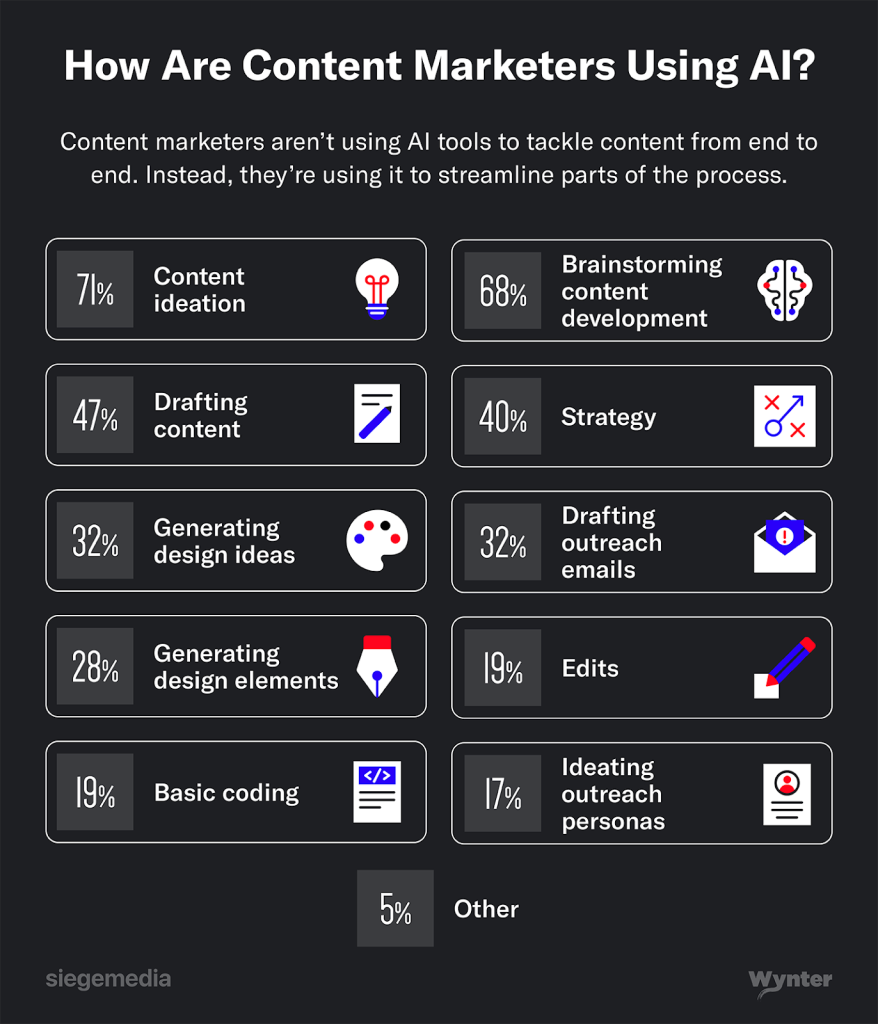
30. 48.6% of Content Marketers Report Above Average Success Without AI Tools
Slightly less (43.8%) report the same level of success with AI.
This goes to show that a human touch is still essential for creating a high-performing content strategy. Of course, AI tools can speed up the process. But they should be used as a complement to human creativity and expertise—not as a substitute.
Final Thoughts
Today, customers are more empowered than ever before
They have instant access to all the world’s information and countless brands to choose from. This gives them the luxury of being extremely selective about which companies to do business with.
Given these facts, marketers must focus on creating authentic, value-driven content that resonates with their audience’s needs. It’s no longer enough to simply promote products—you need to build trust, credibility, and a deep understanding of your customers’ preferences to stand out in an increasingly crowded marketplace.eir path and customizing content based on their specific personas.
Referenced Sources:
